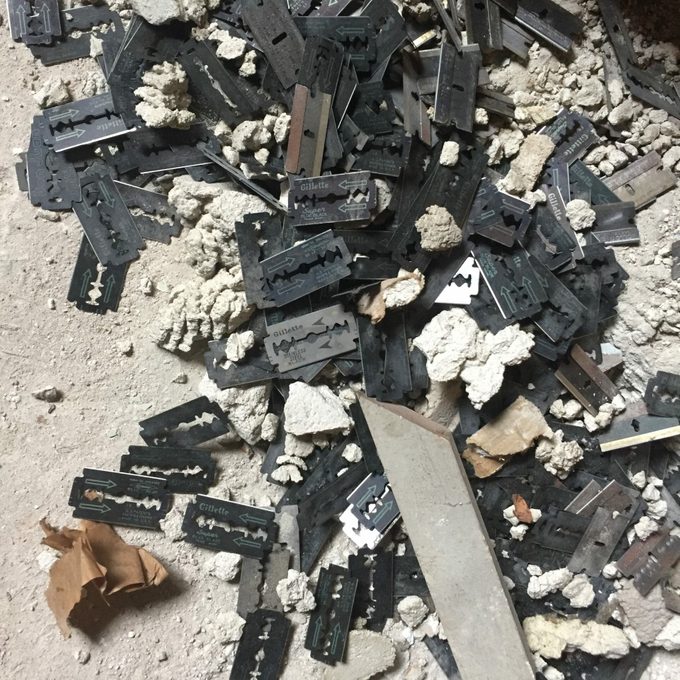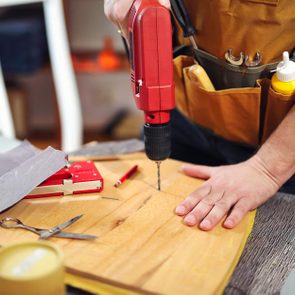Just found a bunch of razor blades in your wall? You're not living in the House of Horrors. Here's what's really going on.

You Might Have Razor Blades in Your Walls—Here’s Why

It sounds like a scene from a horror film: a young, bright-eyed family moves into an old home, ready to fix it up, but when they knock down their bathroom wall, hundreds of old, rusty razor blades come pouring out. Yep, you heard that right. Not a key ring that fell out of a gaping pocket or a pile of old nails—but razor blades in the walls!
This scary-sounding phenomenon is a lot more common than you might think. And there’s a reasonable explanation for your strange wall filling.
To uncover the mystery of why there could possibly be razor blades in the walls of someone’s home, we spoke with Richard D’Angelo, the project manager at JWE Remodeling and Roofing. If you are renovating your home or will be in the future (or are, like us, simply curious!), read on to learn why razor blades in walls are nothing to be afraid of.
Get Reader’s Digest’s Read Up newsletter for more knowledge, tech, travel, cleaning, humor and fun facts all week long.
What do these razor blades in the walls look like?
The blades you might find aren’t your common plastic cartridge blades or anything that might fit a modern men’s or women’s razor. Instead, the blades are from so-called safety razors, which were common in the early 20th century.
In 1903, Gillette introduced the first safety razor to give men an at-home option that was safer and easier to use than the straight-edge version most barbershops used. While these blades took a little more time to master than today’s razors do, they were a vast improvement in terms of usability. Soon, nearly everyone was shaving with them.
Between their introduction and the 1950s, these razors—indispensable as the only method for at-home men’s shaving—began causing a big problem.
How did the blades end up in the walls?

The idea of putting the razor blades in the wall was a direct result of a growing problem: What do you do with used blades?
Because they were sharp (and often contaminated with skin, hair and occasionally blood), you couldn’t just throw the blades into the trash with the rest of your garbage. People had tried that in the ’30s and ’40s, when trash was regularly burned and the ashes spread in gardens. Razor blades generally survived the low heat of a trash fire, becoming huge hazards for gardeners and animals alike.
It was clear that people needed an alternative disposal method, and in the 1950s, they found one … or designed one. “Old medicine cabinets were installed directly inside the interior walls,” D’Angelo told Reader’s Digest. “These old units had a slot in the back that was used to discard used blades, which would allow them to fall into the wall cavity between framing studs and collect on top of the bottom-plate stud.”
The end result: piles of razor blades collecting within the walls. No wonder homeowners today mistake this renovation discovery for a hidden home danger! (For a shocking visual, check out the photo above, taken by Atlanta builder Nancy Keenan, founder and owner of Harris Park Homes, when demolishing a home from the 1920s.)
What was the long-term plan for these razor blades in the wall?
The idea was that it would take centuries to fill up the space between walls with tiny, single blades. By then, folks reasoned, we would have thought of another option.
They weren’t wrong, exactly. We did come up with innovative alternatives. With the improvement and invention of newer methods of shaving and the installation of new medicine cabinets, the wall slots were often plastered over without another thought. Unfortunately, the practice of slipping a razor into a disposal slot has been all but forgotten—until someone tries to knock down an old wall, that is.
“We have found stacks of razor blades in the walls at least a dozen times when we do remodels and restorations of older homes,” says D’Angelo. “We even once found them in the ceiling of the first floor: They fell through the wall from the second-floor bathroom, down a hole made for plumbing pipes and into the ceiling cavity of the kitchen. When we demolished the old plaster ceiling, the razors came raining down. Luckily, no one was hurt!”
FAQs
Do all old houses have a razor slot?
Most houses built between the 1920s and 1970s will have this feature. Before the 1950s, the problem of disposing of used blades had no perfect solution. So people got creative: They slipped them between wall crevices and even tucked them under heavy carpets. Some continued on with these DIY hacks even after the first medicine cabinets with razor blade slots were created. A properly designed razor blade disposal slot is most commonly found in houses built in the half century between the ’20s and ’70s, according to the fact-checking website Snopes.
When did people stop disposing of razor blades in walls?
People ditched razor blade disposal slots sometime around the 1970s. The new and improved blades from Bic helped replace the safety razors used in the decades prior. These lasted longer and therefore needed to be disposed of less frequently. Most people found trashing the new plastic razors much easier.
About the expert
|
Why trust us
At Reader’s Digest, we’re committed to producing high-quality content by writers with expertise and experience in their field in consultation with relevant, qualified experts. We rely on reputable primary sources, including government and professional organizations and academic institutions as well as our writers’ personal experiences where appropriate. We verify all facts and data, back them with credible sourcing and revisit them over time to ensure they remain accurate and up to date. Read more about our team, our contributors and our editorial policies.
Sources:
- Richard D’Angelo, project manager at JWE Remodeling and Roofing
- GQ: “How to Shave with a Safety Razor”
- Gillette: “Safety Razor History”
- Snopes: “Your Older Home Could Have Razor Blades in Its Walls”























